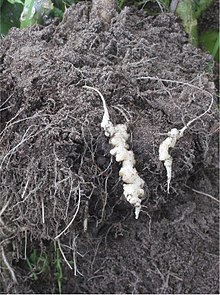en
names in breadcrumbs


The Phytomyxea are a class of parasites that are cosmopolitan, obligate biotrophic protist parasites of plants, diatoms, oomycetes and brown algae.[1] They are divided into the orders Plasmodiophorida (ICZN, or Plasmodiophoromycota, ICBN) and Phagomyxida.[2] Plasmodiophorids are best known as pathogens or vectors for viruses of arable crops (e.g. club root in Brassicaceae, powdery scab in potatoes, and rhizomania in beets, especially sugar beets and some spinaches).[3]
They typically develop within plant cells, causing the infected tissue to grow into a gall or scab. Important diseases caused by phytomyxeans include club root in cabbage and its relatives, and powdery scab in potatoes.[4] These are caused by species of Plasmodiophora and Spongospora, respectively.[5]
The vegetative form is a multinucleate cell, called a plasmodium. This ultimately divides to form new spores, which are released when the host's cells burst. Both resting spores and motile zoospores, which generally have two smooth flagella, are produced at different stages. Within the plasmodium, dividing nuclei have a distinctive cross-like appearance.
Plasmodiophorids were traditionally considered slime moulds, because of the plasmodial stage and are often wrongly classified as fungi, and given names such as the Plasmodiophoromycota. However, genetic and ultrastructural studies indicate they belong to a diverse group of protists called the Cercozoa, are closely related to them.
 Life cycle of Plasmodiophora brassicae in cabbage.
Life cycle of Plasmodiophora brassicae in cabbage.  Clubroot on cauliflower
Clubroot on cauliflower The Phytomyxea are a class of parasites that are cosmopolitan, obligate biotrophic protist parasites of plants, diatoms, oomycetes and brown algae. They are divided into the orders Plasmodiophorida (ICZN, or Plasmodiophoromycota, ICBN) and Phagomyxida. Plasmodiophorids are best known as pathogens or vectors for viruses of arable crops (e.g. club root in Brassicaceae, powdery scab in potatoes, and rhizomania in beets, especially sugar beets and some spinaches).